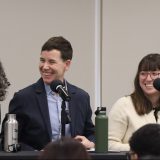
Love’s Story About Excavating at Tel Jezreel
February 7, 2014
A story by Marilyn Love (Religious Studies Major and World Languages and Cultures Minor ’14)
Last summer, I spent four weeks excavating at Tel Jezreel, where I had the privilege of working with an international team of people, and staying at Kibbutz Yizre’el, which is one of the few active kibbutzim remaining in Israel. The Jezreel Expedition is directed by Dr. Norma Franklin (Haifa University) and Dr. Jennie Ebeling (University of Evansville). Tel Jezreel was surveyed in May 2012 using LiDAR technology and GIS mapping in order to determine which areas would be excavated in the first season. After analyzing the LiDAR scans, it was determined that we would open the 2013 season by investigating an Iron Age wine press and an area off the tel near a spring called Ein Jezreel.
I supervised two squares in Area S, the region near the spring. Over the course of the four-week season, we uncovered hundreds of basalt tools, including grinding stones and pounding stones. In Area S we uncovered six walls and five massive pits. These intrusive pits contained broken pottery sherds and basalt artifacts dating as late as the Byzantine period, but underneath the pits we found a Middle Bronze Age stone covering. Once we reached the walls and surfaces, we realized we had several domestic phases of the Early Bronze period. Our small finds were impressive; including a basalt ax blade from the Early Bronze Age, thousands of flint pieces, several spindle whorls, and several Khirbet Kerak sherds.
After the season ended, I worked on a research project that placed our findings from the 2013 season in the Canaanite religious context. I presented my project at the end of the summer at my university’s summer undergraduate research fellowship forum. This experience will indubitably help me to advance in my academic career and has solidified for me that archaeology is a discipline that I want to pursue for the rest of my life.

